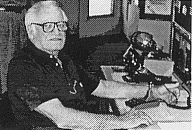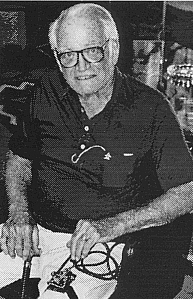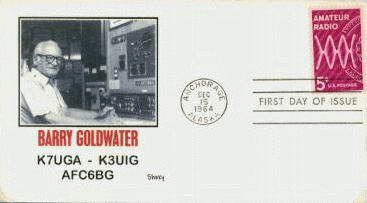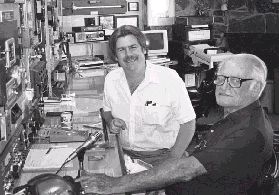|
Since we were researching the early history of radio
broadcasting in Arizona, we dug out a brochure from KOY that LeeAnn and I
used for subject material for another publication we had edited years ago.
In this brochure, we read that former U.S. Senator Barry Goldwater had
worked for a place called Neilson Radio which owned KOY back in the days
when it was called KFCB.
We wrote to Mr. Goldwater to inquire as to his remembrances of the early
days. We expected only a return phone call, but instead we were treated to
an invitation to his house.
The following is a part of our conversation during the time the three of
us spent together one afternoon in June.
Ed - Barry, can you tell us a bit about the early days of
radio in Arizona, especially dealing with your relationship with the
Neilson Radio Company?
Goldwater - Earl Neilson was the first wireless and radio
professional. He started out as a mechanic for the Chevrolet dealership
company, and he started out building wireless sets at night...
When I was in high school I was interested in radio, so I would stop in
and sweep the floor and pick up things... So he finally said I was working
for him, and I worked a whole year and he gave me a headset...
In a little store area he finally had a shop. Was on what we called the
town beach- It was a canal that ran parallel to Van Buren, and it made a
nice place to have a shop due to the fact that if you didn't want
something, you just threw it in the canal.
Earl Neilson had an amateur call 6BBH. I was an amateur also, and my call
was 6BPI. (Earl) had a little transmitter we put together, and I would go
down at night and play phonograph records. I think one night they heard me
in Mesa!
Ed - Was it actually legal to play music over an amateur
transmitting station in those days?
LeeAnn - I don't think there was much regulation in those days.
Goldwater - Well, we never worried about that.
Ed - What year was this that you started working in Neilson's shop?
Goldwater - In 1922 or 23. I was 15. We built the first broadcast
transmitter there. It later became KFAD and now it is KTAR. It was a 250
watt transmitter. There used to be a very prominent family here called
MacArthur. They were in the Dodge automobile business on Jackson and
Central. We put the antenna on their building and started transmitting...
that's about the way broadcasting got started here.
Ed - That station was before KOY then?
Goldwater - Yes! KFAD was first.
LeeAnn - When was the first time you became interested in radio?
Goldwater - I do not remember the exact date, but I remember
telling my father I was interested in wireless. I built this little
crystal set, and that kind of astounded him. So for Christmas he gave me a
little Westinghouse called an Aeriola, Sr. and it helped a lot.
For a transmitter, I used a small Ford spark coil to transmit with. That
we later replaced with a larger spark transmitter, and then with a 20 watt
rig once tubes became more available.
Ed - I have one of those Aeriola, Sr. radios.
Goldwater - Wow! Those are worth a bundle now.

Senator Barry Goldwater
Ed - Our company has taken it upon
ourselves to sponsor a radio museum of electricity and communications.
Goldwater - Well, that is good. We should have done it a long time
ago. To think of all the old equipment I have had over the years. I wish
to God I still had it!
Ed - You never hung on to any of your old equipment you used in
those days?
Goldwater - No, I had a few pieces in my mother's garage, and
people borrowed them...
I can tell you something earlier than radio. The first telegraph was
brought to Phoenix by my uncle. It was an Army line, but he learned the
code and the first call that came through, he answered it. The response
from the other end was, "get the hell off the line!"
I also remember the heliograph. The Army used them to transmit signals all
over the state. There was a very important one up on top of Navajo
Mountain - at about 12000 ft.
There was a lot of early activity in wireless and radio even in the early
days. I would hear someone's call sign and write it down, and go visit
them.
I still stay active with radio. Lately, I have been playing with weather
and fax reception.
Ed - Did you manage to save any of the old books on radio that you
had in earlier days?
Goldwater - No, I do not have any of them anymore. I had one old
call book, but I gave it away to someone who was looking for them.
Ed - The earliest one I have managed to get was 1925.
Goldwater - Well, keep looking, they are around. I think you are on
a worthwhile project and I hope you don't get tired of doing it - it is
needed. No one had ever taken the time to do it.
Mr. Goldwater, LeeAnn and I left the house and walked out towards the
Senator's Ham shack, which is a converted pool house alongside his
swimming
pool.
Goldwater - Here is something you might like for your museum. It is
a military aviator's key. They would clip it on their leg and...

Demonstrating the J47 Leg Key
After a demonstration of the way a J47
aviator's key was positioned and used, the Senator showed us the radio
equipment in his radio room. One item that was great fun was a
"talking" voice synthesizer antenna rotator that he used to
position his beam antenna. It would actually tell you the direction the
antenna was pointing. Except for one old R-388 Collins receiver, all other
equipment was of modern vintage. Barry Goldwater's radio room also sported
a computer used for teletype, FAX, and Morse code. |




